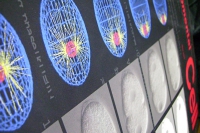Dr. Akatsuki KIMURA's Past Publication
Short Biography
Dr. Akatsuki Kimura received his PhD in Biophysics and Biochemistry in 2002 from the University of Tokyo, Japan. His research, performed at the Institute of Molecular and Cellular Biosciences of the University of Tokyo under the supervision of Dr. Masami Horikoshi, was aimed at understanding the mechanisms to regulate global gene expression through the post-translational modification of histone proteins.
During his postdoctoral work in the lab of Dr. Shuichi Onami at Keio University and at RIKEN institute, he attempted to utilize computer simulation to understand fundamental questions in cell biology, focusing in particular on how nucleus position itself at the center of the cell in the C. elegans embryo.
In June 2006, he was appointed as an associate professor of Center for Frontier Research at the National Institute of Genetics, where he started his independent laboratory. A major goal of the lab is to reveal “(hidden) orders,” which is a pattern/regularity in the spatial organization of cells, and to understand the underlying physical foundations of those orders.
Past Publication
- Kimura A. and Onami S. “Local cortical pulling-force repression switches centrosomal centration and posterior displacement in C. elegans.” (Letter) Journal of Cell Biology 179, 1347-1354 (2007).
- Kimura A. and Onami S. “Computer simulations and image processing reveallength-dependent pulling force as the primary mechanism for C. elegans male pronuclear migration.” (Article) Developmental Cell 8, 765-775 (2005). *論文の表紙に採用されました*
- Kimura A., Matsubara K. and Horikoshi M. “A decade of histone acetylation: marking eukaryotic chromosomes with specific codes” (Review) Journal of Biochemistry (Tokyo) 138, 647-662 (2005).
- Kimura A. and Horikoshi M. “Partition of distinct chromosomal regions: Negotiable border and Fixed border.” (Review Article) Genes to Cells 9, 499-508 (2004).
- Miyamoto S., Suzuki T., Muto S., Aizawa K., Kimura A., Mizuno Y., Nagino T., Imai Y., Adachi N., Horikoshi M. and Nagai R. “Positive and negative regulation of the cardiovascular transcription factor KLF5 by p300 and the oncogenic regulator SET through interaction and acetyltion on the DNA-binding domain.” Molecular and Cellular Biology 23, 8528-8541 (2003).
- Kimura A., Adachi N. and Horikoshi M. “Series of vectors to evaluate the position and the order of two different affinity tags for purification of protein complexes.” (Article) Analytical Biochemistry 314, 253-259 (2003).
- Kimura A., Umehara T. and Horikoshi M. “Chromosomal gradient of histone acetylation established by Sas2p and Sir2p functions as a shield against gene silencing.” (Article) Nature Genetics 32, 370-377 (2002).
- Adachi N., Kimura A. and Horikoshi M. “A conserved motif common to the histone acetyltransferase Esa1 and the histone deacetylase Rpd3.” Journal of Biological Chemistry 277, 35688-35695 (2002).
- Suzuki T., Kimura A., Nagai R. and Horikoshi M. “Regulation of interaction of the acetyltransferase region of p300 and the DNA-binding domain of Sp1 on and through DNA binding.” (Original Article) Genes to Cells 5, 29-41 (2000).
- Kimura A. and Horikoshi M. “Tip60 acetylates six lysines of a specific class in core histones in vitro.” (Original Article) Genes to Cells 3, 789-800 (1998).
- Kimura A. and Horikoshi M. “How do histone acetyltransferases select lysine residues in core histones?” (Hypothesis) FEBS Letters 431, 131-133 (1998).

